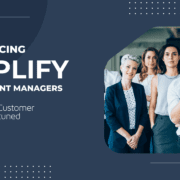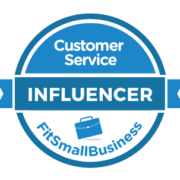Customer Centricity Corner with Peter Lavers – Using Customer Segmentation Models
CUSTOMER CENTRICITY CORNER – Using Customer Segmentation Models
Customer Attuned director and CX Influencer, Peter Lavers, talks with Appreciate Group’s Martin Cooper in this, the second in our series that explores Customer Centricity. In this chat, Peter and Martin consider the use of customer segmentation models in applicable ways and bring up sales, collaboration and data among other challenges.
![]() If you are challenged by the use of customer segmentation within your organisation, let us help. To begin a no obligation chat, please contact us.
If you are challenged by the use of customer segmentation within your organisation, let us help. To begin a no obligation chat, please contact us.
The Transcript
Introduction to Customer Centricity Corner
Peter: Welcome to the latest Customer Centricity Corner. Brought to you by Customer Attuned Limited.
In this series I’m discussing different aspects of customer centricity in the business to business sector, which of course is also known as B2B.
Our focus in these short 10-12 minute interviews is on the practicalities, how do we apply the theory, and of course overcome the obstacles to make our places of work more customer centric?
I’m speaking with a range of practitioners and experts in the subject, each with different insights to share. And I’m delighted to introduce Martin Cooper from Appreciate Group. Appreciate Business Services, part of the Appreciate Group Plc, work with tens of thousands of businesses to motivate and engage employees and incentivize customers with their products such as Love to Shop, Gift Card and Ecodes and SaaS Solutions. They build reward programmes and support client solutions to help them grow their businesses. And Martin is their Head of Client Development.
Introduction to using customer segmentation models
Our subject today is about the operationalisation of customer segmentation models through sales and accounting, who of course have limited resources and they’re under pressure to deliver. Martin, please tell us more.
Martin: Yeah, well, it’s the whole square in the circle, isn’t it, Peter? Particularly in a tight sales team like we have, I’m sure it’s fairly common to have too many clients and not enough resources. I mean, if you’re looking off to work kind of one to one or want to few, that’s great.
I’d kind of love to operate like that, but we’ve got 30,000 plus corporate clients. So how do you square that circle? Because if you effectively, if you if you divide those up between the resource that you have and you end up with too many clients to deal with, for each of your team members, they’re going to struggle. You’re not going to be able to contact their clients frequently enough. You’re not going to be able to squeeze the sponge, as we say, dig out those opportunities, and so you’re not going to be able to do the job that needs to do it. But equally, if it goes the other way and you say, okay. And generally over the years, what we’ve tried to do is actually reduce the number of accounts that the guys have to look after.
That can also work against you as well because sometimes you’re missing the opportunities that are sort of coming up elsewhere while you’re focused on this sort of pot of account. And then actually, if you’re not getting the numbers coming through, then the team starts to get demotivated as well because it’s not due to their work, it’s kind of happened elsewhere or you’ve missed it. So it’s kind of how do you square that circle of what’s the magic number? We’re always chasing for what’s the magic number to do, so that’s the dilemma.
Peter: So you’ve obviously been facing this and I think a lot of our listeners will identify this as a very common thing that’s come up right across the sectors within B2B. What approaches have you found actually have worked best and how have you helped stop the customers falling between the gaps and of course, the opportunities falling between the cracks as well?
Martin: Yeah, well, we really believe that collaboration is the key to this not standing alone just as a standalone sales team. And it’s only our job to kind of look after this basket of accounts that we’ve got, which we know we can’t just do with a simple, okay, well, let’s do the best that we can with the people that we got. Really, we need collaboration. It’s really what I would encourage people to do today is really perhaps reach out and think of kind of other teams, internal stakeholders a little bit differently.
So for example, we’ve worked with marketing very differently than perhaps we have done in the past because traditionally marketing we feel, okay, well, they’re just about customer acquisition, they’re just about filling that pot. They’re about going and finding those leads and then pushing them through to perhaps the new business to the team. Well, how do they work with us on the existing client team as well? And the way that we’ve really kind of done that more with the marketing team is really using the marketing techniques and almost using them as the voice of the sales team, actually getting them to voice communications as though they were the sales team.
So what it means, what that means is they can do outbound campaigns in the sort of the voice and the name of certain of the sales team in particular sectors, for example. And it’s difficult, it’s not easy because it has to be authentic, if you like. It has to be the person that they’re expecting and it has to use the right tone of voice.
They have to have the knowledge, if you like, to put that across as though that was a personal e-shot that was sent out by the team owner themselves.
But what’s really exciting is when you see actually clients responding to their outbound marketing activity, believing that it was, if you like, one of the team that sent that and saying, “Oh, hello Dave, thanks for that. It’s interesting, I didn’t know you’d launch that kind of new product service. Tell me more a little about that…”
Because straight away we’ve got that opportunity. We’ve obviously, if you like being authentic enough to get them to respond in that way and then obviously we can take it forward then with one of the teams. So it’s just that sort of marketing led approach really helps us to sort of sift, see the wood for the trees, if you like, and do it that way. So that’s kind of one example of that.
The other stakeholder we reached out to quite a lot of is that are the BI teams and again, you tend to think of those as just giving you the data. Okay, you’ve done the activity. “Okay, tell us how we’ve done BI guys. Okay, well, this is how we need to respond…”
But they’ve done a really good job. We haven’t been working with them too long now, but what they’ve started to do is put together what we call propensity models. So using the data that we’ve got, using the activity that we’ve done as a sales team, they can start to build some quite clever sort of rule based analysis and start to then feed to the team to say, well, of all of those clients, most of which you won’t have a chance to speak to, this segmentation of clients is behaving in a way that we believe is that shortly there are going to be in that sales cycle because of previous activity. That has proved that to be the case.
Now, it’s quite early days yet, so it’s one of those things that you need to do more the more work you do and it the better it refines it and the better accuracy we get. But the early results are really exciting with that. I think that could be the absolute nugget, the real secret, the secret source of making a big difference to how do we address this vast client base.
Actually it’s using data and the analysts to flush that out. It’s really exciting. I think it’s not quite AI, but it’s along that it sort of feels as low as that could be the case. I think. Lastly, if I’ve got the time to say this, we’ve been talking about internal stakeholders, but actually we’ve been starting to use kind of lead generation agencies, which I’d always been a little bit cautious of before.
Because you’ve got this pride thing. “Well, only I know, only my team now has the knowledge.” I don’t want to endanger that actually. Is it sort of turkey is voting for Christmas? What if they’re too good, if you like. So sometimes we’ve held up from that, but we started to use this particularly in peak times. We do a huge amount of our business in these three months leading to Christmas and again, we haven’t got the resource to get out to everybody. So we found an agency and you have to work hard to find the right one.
But I’ve been absolutely stunned by the quality and their ability, the speed of learning to again, a little bit like the marketing activity of kind of using the right tone of voice, getting up to speed to actually now they can’t complete the sale in a lot of occasions, but what they can do is either. We spent time trying to automate some of that activity. That lead generation, if you like, that doesn’t require handholding or developing further by us as a sales team.
So that’s kind of good. So that just goes through and just because it’s a transactional sale that can go straight
through, but also then to sort of pass it on to the team without the client kind of seeing the join and kind of almost again, kind of seeing behind the scenes a little bit.
It feels so authentic that it was somebody that got them to a point and now they’re being passed on to somebody else within the sales team and the client doesn’t feel that clunky. But you have to be slick, you really have to work hard. But again, it’s just separating out the wood from the trees, the good stuff from the transactional stuff that we can go elsewhere. So that’s really, I think, the core of what I wanted to say today. It’s only kind of one aspect of it, but it is this idea of perhaps using other teams in slightly different ways than you’ve used them before as part of this customer centric sales function, if you like, because you don’t have to don’t always have to be us. If you like, they can do some of the work for you and if you kind of let them do it, you can be really surprised about what a great job they can do.
Peter: Thank you so much, Martin. There is so much insight in that. Just about ten minutes of download now. I really appreciate it and thank you for telling your story. Thank you for those insights.
Using Customer Segmentation Models Summary
Peter: For me, one of the things that really kind of comes out of that is this need for customer centricity to be seen across all departments and actually all working together on that goal, which authenticity is something that a lot of people talk about, but at the end of the day, you can only finally ask the customer about that. We can try to be as authentic as we like, but the customer is the final judge of that.
For me, that is a key take out of this. Our desire for customer centricity has got to go all the way through our departments, through the way we organise, and the customer is the final judge of how well we’ve achieved that. So thanks again, Martin. I really appreciate that.
Just for our viewers and listeners, please go to our website, which is CustomerAttuned.com, to get the links to the rest of this series and also to see what else we do. Our purpose as Customer Attuned is to build a culture of customer centricity based on trust, to establish sustainably, mutually beneficial and profitable B2B relationships.
And I hope what you’ve heard today helps you on your journey. Thanks for listening and thanks again to Martin Cooper from the Appreciate Group for being our speaker today.
- Customer Strategy in the B2B Membership Sector - May 27, 2025
- Build a B2B Customer Strategy - May 20, 2025
- Should you implement NPS in B2B? - January 22, 2025






